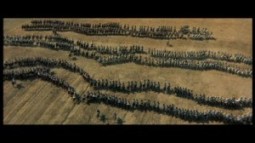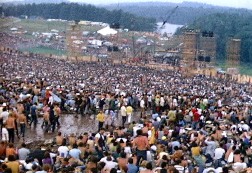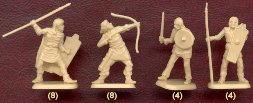Scale: What Pre-Modern Battles Really Looked Like

That battle scene from Gladiator?
More men, please! Where you see a line of Romans, imagine five. Ancient armies numbered in the tens of thousands.
Sure, a thousand be-weaponed extras on-screen makes your mind go “1…2…3… Lots.” But real battles were several orders of magnitude larger.

Remember the Rod Steiger Waterloo? More cavalry, please! That should be 9,000 sabres. When you measure it out, they should fill the space between the two farmsteads. The only reason the Allied Infantry didn’t turn tail and run was because Wellington had positioned them behind a ridge so that they couldn’t see the tsunami of horseflesh about to wash around their squares.
Take an earlier battle on the same scale; Chalons — Huns and “allies” versus some Romans and lots of Romanized barbarians who hated each other. Jordanes says Chalons left 150,000 men dead on the field. That has to be a wild overestimate. However, suppose he’s out by a factor of ten and the body count reflects 10% of the men fighting… that takes us back to one hundred and fifty thousand warriors jostling and yelling, say about 75,000 a side.

What would that really look like? Well, here’s a slice of 60,000 people (see right… Yes, I know, it’s Woodstock 1969.)
You can feel the pressure of the other people off-screen, even if you can’t see them.
Screw your eyes up so that the picture blurs and imagine helmets and spears… turn those long-haired peaceniks into Romans, Alans, and Visigoths.
Now, since that worked so well, replace the stage, the tents, as far as the trees with horsemen… yes, the Huns and the Ostrogoths are coming!
Finally, drop yourself into the middle of the crowd, share the air with seventy-five thousand other warriors, try to keep your shield free enough to cover yourself when the arrows fall. Wonder what’s happening up front… how far away the front actually is.
Welcome to Northern Gaul, AD451!
Hand to hand they clashed in battle, and the fight grew fierce, confused, monstrous, unrelenting—a fight whose like no ancient time has ever recorded. There were such deeds done that a brave man who missed this marvelous spectacle could not hope to see anything so wonderful all his life long. For if we may believe our elders a brook flowing between low banks through the plain was greatly increased by blood from the wounds of the slain. Those whose wounds drove them to slake their parching thirst drank water mingled with gore. In their wretched plight they were forced to drink what they thought was the blood they had poured out from their own wounds. (Jordanes)
So, armies of the past were mind-blowingly big; beyond all normal human scale. For us, they’re bigger than a busy high street and into rock festival territory.
For a native of the times… well, 12th century London was about 10,000 people. A Medieval army would have reminded a burgher of the last time everybody poured out into the street to cheer His Majesty. Classical and ancient cities could have populations in the hundreds of thousands, so, since the battles could be bigger, the comparison holds. Except that the townscape obscures the numbers, not everybody is trying to kill each other and not everybody in an army is used to urban life.
The scale is more than an aesthetic thing. It explains a lot about battles — how confusion could spread so easily… how a mass of non-warriors could trundle over a smaller number of better fighters… how rivers could run red with blood.

Ways to get your head around the visceral vastness of pre-modern warfare:
- Get hold of a box of 20mm figures — HAT are good for most periods — create a slice of the battle, then scale up. You can also create the front and side of a unit, e.g. a box of 60 figures can give you 10 x 50 = 500 men. Somehow the little figures make it seem more real. When Kurtzhau and I did this for the infantry columns at Waterloo, his bedroom floor quickly filled with imaginary rectangles of men. We did this with Playmobil and realized that his bedroom, the bathroom, and our master bedroom would just about contain the French chivalry at Crecy.
- Take your calculations, convert to paces, and take a trip to the local park. When last I checked, a pace is about 2/3 of a meter. Start off by walking out the effective ranges of the weapons. 100 yards suddenly feels like a long way! Walk the length of the armies and try to imagine how command and control might work.
- Go to a real battlefield. Preferably pick one like Flodden, where it’s not been built over. Visualize, imagine what you could see and what you could not. Would you know what was happening on the other flank? Or how that cavalry skirmish was going? Finally, walk the path of an attack and calculate how many volleys of spears, arrows, or musket balls you would take.
- Go to an open air concert and find out the number of tickets sold.
Do some or any of these and you’ll have a far more vivid idea of what a pre-modern battle might have felt like. The downside is you’ll be much less impressed by war films than before, even the CGI ones.
Yes, one-thousand extras going “Rah!” can fool you into thinking you’re seeing more, but the real numbers… they’re like a punch in the gut.
M Harold Page (www.mharoldpage.com) is a Scottish-based writer and swordsman. His debut novel The Sword is Mightier came out recently. His Foreworld SideQuest, Marshal versus The Assassins is available on Amazon for preorder.
What Fun! Informative and exciting! Works quite well with Paul Kearney’s essay in WFH too 🙂
Excellent post. Thanks!
@ RBE Jason – Yes indeed. Kearney is one of the few writers that really gets battles right. (Though the first draft of this blog post predates Writing Fantasy Heroes by a few years 🙂
I remember when I went to my first medieval style war. There were over 2,000 fighters on the field. We were evenly distributed into two separate armies. The frontage of both armies took up 150 to 200 yards respectively. Two Rugby Pitches wide and we still had a depth of five men.
It made it readily clear two things. Leading from the front, was almost the only way you could. Vision on a flat plain is limited to the back of the helms of the men in front of you. Leaders needed to be mounted most of the time just so they could exercise some form of command and control. By the time the Napoleonic wars came about most participants had developed mounted staff corps to deal with moving troops. GREAT POST!
Yep, great post!
As I recall, Thomas Harlan’s Oath of Empire series (alternate history Roman/Persian war with magic) had some of that same sense of scale to the battles.
What a great post!
Been decades since I’ve read any Livy, but I seem to recall him describing ancient Roman and Carthagenian armies containing hundreds of thousands of soldiers. I’d always been a bit skeptical of those numbers, but this post has got me rethinking that.
Xenophon’s Persian Expedition has a wonderful description of the Persian army emerging over the horizon.
[…] Scale: What Pre-Modern Battles Really Looked Like […]
[…] battle he skims over is the apocalyptic Ragnarok-class battle of Chalons, basically Waterloo with more body armour and no gunpowder. It happened because Aetius managed to […]